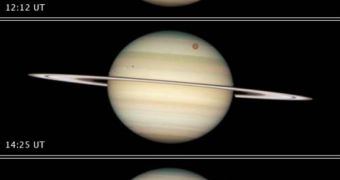The Hubble Space Telescope proves, indeed, to be invaluable for both NASA and ESA, as evidenced by one of its recent snapshots of Saturn, which has been photographed in a rare alignment with four of its moons. The configuration only occurs once in 14 to 15 years, and the last time astronomers and other observers were able to see a similar one was in 1995-1996. The pictures taken on February 24th also depict various stages of the event, as they were snapped several minutes apart.
During the new observations, Saturn was some 780 million miles (1.25 billion kilometers) away from the Earth, and yet the space telescope was able to resolve details as small as 190 miles (300 kilometers) across on the gas giant. Thus, it was successful in seeing the four moons appearing on the “bright side” of the target planet, as well as their evolutions within a few hours. The shadows of some of the natural satellites were also observed, trailing their “owners” on the surface of the planet.
The reason why these occurrences are so rare as viewed from the Earth pinpoints to the orientation of Saturn's rings. When they get to be almost perpendicular to our planet, as in how we view them, these lunar configurations appear very clearly. However, when the rings are in some other position, they conceal what is happening inside them and thus only a few moons can be directly observed, but in no configuration whatsoever. On August 10th and September 4th, 2009, the gas giant will move its rings head on to our position, and other spectacular views could be possible.
Saturn was first observed through a telescope by Italian astronomer Galileo Galilei, who was put under charge of heresy by the Inquisition and forced into house arrest for the remainder of his life for these very investigations. During that time, he continued his observations of planets and moons in our solar system, and this is one of the main reasons why Saturn's four largest natural satellites are called the Galilean Moons. As proof that science evolved, the new snapshots were taken with Hubble's Wide Field Planetary Camera 2, a better telescope than Galileo's.

 14 DAY TRIAL //
14 DAY TRIAL //